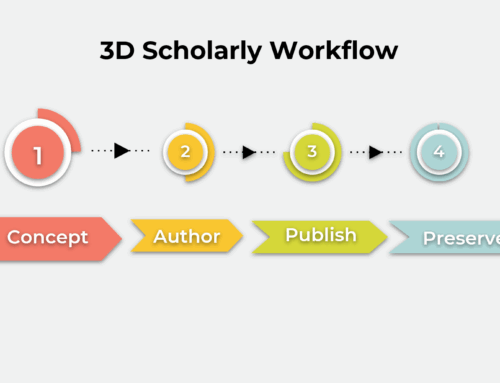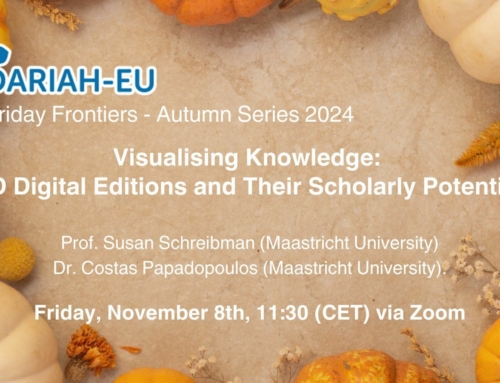PURE3D presented during the CAA 2025 International Conference (Athens, 5-9 May), the paper Workflows for 3D Scholarship: Conceptualising, Authoring, and Publishing 3D Scholarly Editions within a National Infrastructure:
For the past 20 years, 3D media have been struggling to gain a foothold in open science initiatives for cultural heritage. They are either offered as accompanying downloads for offline exploration or they are presented in a 3D viewer that offers limited visual inspection and often even less in terms of annotation or semantic enrichment. Many concerted efforts have sought to address 3D data curation and publication at various levels – from standards for 3D digitisation methods, to consistent metadata and paradata, from web streaming to peer review protocols (Alliez et al., 2017; Hardesty et al. 2020; VIGIE 2020/654; Moore et al. 2022; Papadopoulos 2024). While all these aspects of making 3D digital heritage part of the scholarly research ecosystem are crucial for data quality control and long-term preservation, there is a lack of (sustainable) infrastructures that combine a viewing and repository function, as well as tools that would allow the enrichment of 3D models that turning them into useful scholarly resources. Such infrastructures require not only robust software and hardware but also humanware, i.e., expertise in infrastructure development and operation, as well as a diverse user community with varying disciplinary backgrounds and digital skill levels. These elements are essential for sustaining such systems.
PURE3D (funded by the Dutch PDI-SSH (Platform Digitale Infrastructuur–Social Sciences and Humanities) is addressing the infrastructure concerns raised by prior digital humanities scholars and 3D heritage working groups while also centering the perspectives and experiences of stakeholders. This is being done through the development of a prototype infrastructure dedicated to fostering the creation of 3D Digital Scholarly Editions by individuals from across the humanities, sciences, and social sciences – from students to curators, from public sector officials and museum staff who inherit commissioned 3D assets to researchers with experience in creating 3D models themselves. 3D Digital Scholarly Editions are an intermedial constellation of knowledge within which 3D models embed within them scholarly arguments (in the form of metadata, paradata, annotation, and argument), as opposed to the ways in which 3D models are currently engaged with: as ‘twirly things’ available on a platform such as SketchFab (with limited annotation available) or in surrogates such as videos and 2D images in published articles. While a 3D edition can in theory be constructed in any feature-rich 3D web viewer, the PURE3D infrastructure currently deploys the Smithsonian Voyager 3D viewer for editing and publishing the 3D projects. Besides being an open-source software with a long-term outlook for committed development and maintenance, the framework offers a user-friendly editing interface called Voyager Story that can empower non-technical edition creators (with training) to curate their knowledge and expertise around a 3D digitised object or through a 3D reconstructed scene.
At the same time, PURE3D, funded by NWO Open Science, researches – in the context of research assessment reform, how 3D is valued and rewarded as scholarship in its own right, and how an evaluation system designed for this particular output enhances the quality and reach of open science in our field. While previous efforts by journals to publish peer-reviewed research incorporating 3D components have been fragmented or unsustainable, PURE3D engages stakeholders to understand their challenges in having their work evaluated. This dialogue informs the development of an evaluation framework – both conceptual and technical – that redefines how 3D scholarship is valued.
Over the past four years, PURE3D has uniquely bridged infrastructure development with community building among 3D scholarly edition creators. This dual focus has enabled reflection on workflow – from data handling and preservation concerns and a critical evaluation of outputs by both experts and end users. This presentation will outline the development of the PURE3D infrastructure, the establishment of workflows – from conceptualising to publishing 3D scholarly editions, and will reflect on lessons learned. It will also propose future directions for infrastructure development in light of current EU initiatives and the impending closure of SketchFab’s ad-hoc role as a repository for digital heritage.
References
Alliez, P., Bergerot, L., Bernard, J-F., Boust, C., Bruseker, G., et al. (2017). Digital 3D Objects in Art and Humanities: challenges of creation, interoperability and preservation. White paper. [Technical Report] European Commission; Horizon H2020 Projects., pp.71. https://inria.hal.science/hal-01526713v2
Cyprus University of Technology (2022). Study on quality in 3D digitisation of tangible cultural heritage: mapping parameters, formats, standards, benchmarks, methodologies and guidelines: final study report. Project code VIGIE 2020/654. Luxembourg: Publications Office of the European Union [online]. Available from: https://doi.org/10.2759/471776
Hardesty, J., Johnson, J., Wittenberg, J., Hall, N., Cook, M., Lischer-Katz, Z., Xie, Z., & McDonald, R. (2020). 3D Data Repository Features, Best Practices, and Implications for Preservation Models: Findings from a National Forum. College & Research Libraries, 789–807. https://doi.org/10.5860/crl.81.5.789
Moore, J., Rountrey, A., & Scates Kettler, H. (Eds.). (2022). 3D Data Creation to Curation: Community Standards for 3D Data Preservation. Association of College and Research Libraries. https://bit.ly/ACRL3Ddata
Papadopoulos, C. (2024). A Leap of Faith: Revisiting Paradata in 3D Scholarship. In: Huvila, I., Andersson, L., Sköld, O. (eds) Perspectives on Paradata. Research and Practice of Documenting Process Knowledge. Management and Organizational Learning, vol 13. Springer, Cham. https://doi.org/10.1007/978-3-031-53946-6_4





